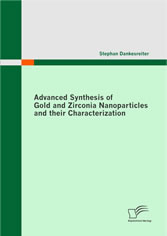Suchen und Finden
Service
Advanced Synthesis of Gold and Zirconia Nanoparticles and their Characterization
Stephan Dankesreiter
Verlag Diplomica Verlag GmbH, 2011
ISBN 9783836641999 , 169 Seiten
Format PDF, OL
Kopierschutz frei
Geräte
Advanced Synthesis of Gold and Zirconia Nanoparticles and their Characterization
1
Table of Contents
5
Part I. Introduction
9
Part II. Fundamentals
15
1. Plasma oscillation and Mie’s theory
17
1.1 Principles of plasma oscillation
18
1.2 Scattering and absorption of small particles
20
2. L(+)-ascorbic acid and its derivates
23
2.1 Chemical properties of ascorbic acid
23
2.2 AscX surfactants and their aggregates
25
2.3 The formation of gel and coagel
30
3. Zirconia and its different structures and species
32
3.1 Zirconyl chloride in aqueous solutions
32
3.2 Structures of zirconium oxide
35
4. Structural investigation techniques
45
4.1 X-ray based methods
45
4.2 Electron based method: scanning electron microscopy (SEM)
70
Part III. Experimental
73
5. Chemicals
75
5.1 Preparation of Gold Nanoparticles
75
5.2 Preparation of zirconium-based nanoparticles
75
6. Analytical Methods
76
6.1 Thermogravimetric analysis (TGA)
76
6.2 Differential scanning calorimetry (DSC)
76
6.3 Bright field and phase contrast microscopy
77
6.4 UV/Vis absorption
78
6.5 Raman measurements
79
6.6 Small angle X-ray scattering (SAXS)
80
6.7 X-ray diffraction (XRD)
81
6.8 Scanning electron microscopy (SEM)
82
7. Synthesis of L(+)ascorbyl stearate (Asc18)
83
8. Synthesis of Gold Nanoparticles
85
8.1 Preparation with Asc18 surfactant
85
8.2 Preparation with Asc12 surfactant
86
8.3 Preparation with Asc14 Asc10 and Asc8 surfactants
87
9. Preparation of ZrO2- nanoparticles
88
9.1 Synthesis of zirconium hydroxide by coprecipitation in homogeneous phase (sol)
88
9.2 Preparation of hydrous zirconia gel
88
Part IV. Results and Discussion
91
10. Gold nanoparticles
93
10.1 Determination of the cmt of Asc18
93
10.2 Synthesized nanoparticles and their colors
94
10.3 UV-Vis characterization
98
10.4 SAXS characterization
109
10.5 Conclusion
121
11. 3. Zirconium hydroxide and oxide nanoparticles
123
11.1 Raman characterization
123
11.2 Dialysis of the sol and an aqueous ZrOCl2 solution
125
11.3 Characterization with microscopic methods
127
11.4 DSC measurements of the gel
132
11.5 Characterization by SEM
135
11.6 SAXS characterization of the gel
138
11.7 TGA and DTG measurements
143
11.8 XRD characterization of calcined samples
147
11.9 Conclusion
152
Part V. Annex
155
Service
Shop



















